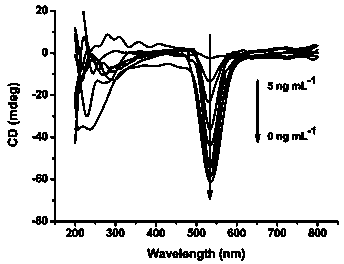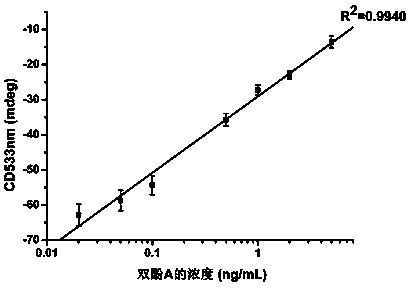Method for detecting bisphenol A by utilizing aptamer-based chiral sensor
An aptamer and sensor technology, applied in the field of nanobiotechnology detection
- Summary
- Abstract
- Description
- Claims
- Application Information
AI Technical Summary
Problems solved by technology
Method used
Image
Examples
Embodiment 1
[0021] An aptamer-based chiral sensor detection method for bisphenol A, the steps are:
[0022] (1) Gold nanoparticle modified DNA probe
[0023] Firstly, the newly synthesized 10nm and 20nm gold nanoparticles are concentrated 5 times to make the final concentration of 20 nM and 5 nM respectively, and then the gold nanoparticles and DNA are coupled according to the molar concentration ratio of 1:5, that is, 1 μL 2.5μM BPA aptamer (Aptamer) was modified on the surface of 20nm gold nanoparticles, 1 μL 10μM BPA aptamer partial complement sequence (Aptamer-C) was modified on the surface of 10nm gold nanoparticles; aged by adding salt Methods Gradually add NaCl to the gold nanoparticles to make the final concentration of NaCl reach 50 mM; after overnight incubation, the gold nanoparticles are centrifuged to remove uncoupled DNA;
[0024] Aptamer: 5’-SH-CCGGTGGGTG GTCAGGTGGG ATAGCGTTCC GCGTATGGCC CAGCGCATCA CGGGTTCGCA CCA-3’;
[0025] Aptamer-C: 5'-CCCACCTGAC CACCCACCGG-SH-3'.
[0026] (2) ...
PUM
 Login to View More
Login to View More Abstract
Description
Claims
Application Information
 Login to View More
Login to View More - R&D
- Intellectual Property
- Life Sciences
- Materials
- Tech Scout
- Unparalleled Data Quality
- Higher Quality Content
- 60% Fewer Hallucinations
Browse by: Latest US Patents, China's latest patents, Technical Efficacy Thesaurus, Application Domain, Technology Topic, Popular Technical Reports.
© 2025 PatSnap. All rights reserved.Legal|Privacy policy|Modern Slavery Act Transparency Statement|Sitemap|About US| Contact US: help@patsnap.com


